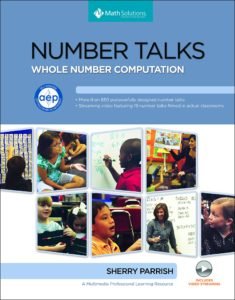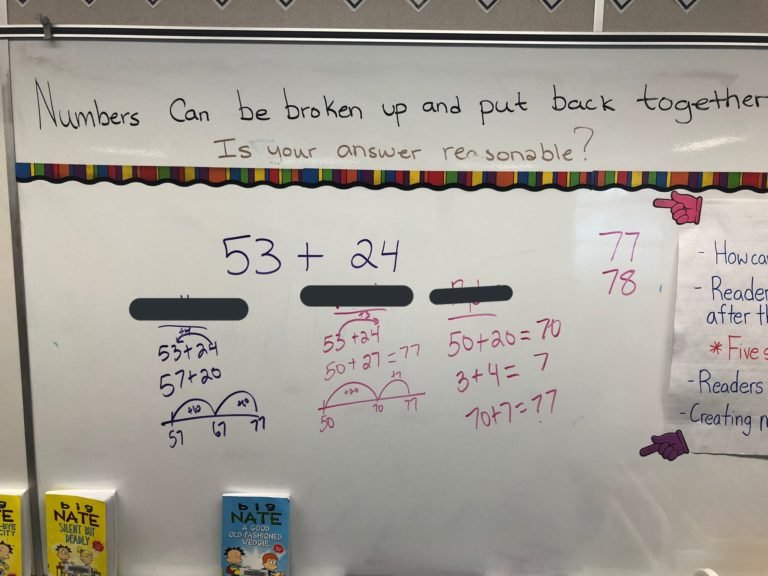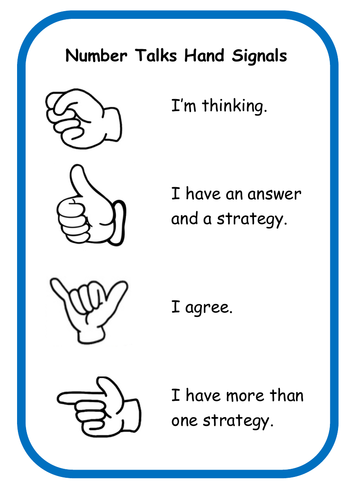Working Through Number Talks
What is it?
Number talks is a brief, ongoing math routine that helps students develop number sense and computational fluency. If you are new to Number Talks, I recommend the following books which have helped me along my journey over the years.




I have been using number talks in my elementary math classroom for seven years now and I thoroughly enjoy them and so do my students. The amount of growth in number sense, discourse and confidence in my students has been attributed to the use of Number Talks and the tweak I made six years ago.
Here is how a typical number talk would play out:
Students gather on the carpet in a half circle facing a whiteboard (if your room is not large enough you may have your students stay at their desks)
The teacher will write the problem horizontally on the board for students to solve mentally.


Students begin by placing their fists on their chest and begin thinking of ways to solve the problem. Once a student has solved the problem using a strategy, they extend their thumb from the fist that is against the chest.
Students will continue to solve the problem using a different strategy and will extend another finger (now showing the thumb and index finger against their chest) indicating to the teacher they have solved the problem using two different strategies.
Once the teacher has scanned the room looking for thumbs up or a good amount of time they will ask for students to raise their hand and share the answer to the problem as the teacher writes them on the board (students like to go into sharing their strategy right away but we have to hold off until we have all the possible solutions students came up with).
Students then decide which answer they would like to defend and begin sharing their strategy to solving the questions as the teacher writes out the strategy on the board (it is important for the teacher to use models that best suit the strategy and ensure they do not steer the students thinking to where the teacher wants it to go).
Classmates may agree or disagree with their peer’s strategy and can explain why.
The teacher can select one or two more students to defend a different solution or the same solutions but using a different strategy.
As I used Number Talks in my classroom, we continually ran into the same four problems that included a lack of time, difficulty of questions, sharing opportunities and constantly using the same strategies.
Lack of Time
Difficulty of Questions
Sharing Opportunities
Same Strategies
The Four Problems I Ran Into
Lack of Time
As with any new routine I knew it was going to take longer than anticipated in the beginning, but I could never seem to get it to fit into a fifteen-minute window. By the time you give grade three students time to think about the questions, take in all the possible answers and have two or three students explain their strategies (which some take no time at all and others take fair bit of time) it was taking up 25 to 30 minutes of the math block. I needed to tweak things.
Students had a tough time engaging in some Number Talks because the difficulty of questions we were taking up as a class. When I would select a string of questions, I would have (1) students who struggled to use a strategy and produce an answer mentally, (2) students who worked through the questions and had a strategy or two and (3) students who could produce the answer having multiple strategies. When choosing the string of questions, I would always be dealing with the disengagement of students because they either struggled or who were not challenged. I needed to tweak things.
Difficulty of Questions
Sharing Opportunities
No matter what questions I selected as the string for Number Talks, there would always be some students who did not want to share their strategies or answers (I never make a student share if they do not want to). Without a doubt you would have the same students who were anxiously waiting to share their strategies with you and the class. I needed to hear from other students in the class without putting them on the spot, making them nervous or forcing them to speak up in front of their peers. I needed to tweak things.
Switching up the string of questions to elicit different strategies from students worked for some students but not for others. It seemed there were always students who would use the same strategy regardless of the questions posed. Some strategies were efficient, but I wanted students to become flexible in the strategies they could rely on. There were times where I would ask students to try and use a different strategy. Some students were reluctant to share in front of the class as they worked through trying different strategies. I needed to tweak things.
Same Strategies
Join me as I discuss the tweak and solution that addressed these problems and improved my Number Talks routine.
Facebook
Twitter
